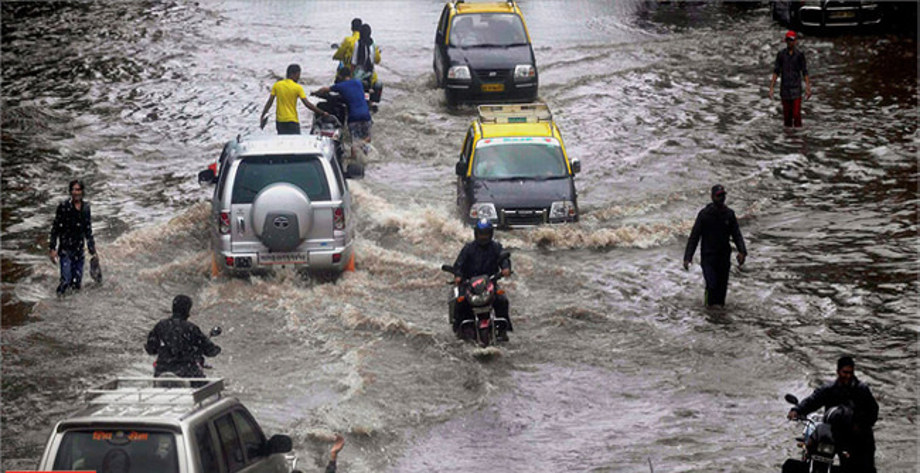A complete shut-down due to floods has become a regular occurrence amongst large Indian cities. With crumbling infrastructure and government apathy, the financial capital of Mumbai is vulnerable to floods every year during the annual monsoon season.
On August 29, Mumbai received 322mm of rainfall in just 24 hours, according to data recorded by the Indian Meteorological Department. The flash floods caused by this rainfall led to the death of 14 people and stalled critical infrastructure as commuters spent the night stranded outdoors. A day later, on August 30, an old building collapsed in South Mumbai leading to the death of 30 people and leaving over 15 people injured.
The death toll included one prominent surgeon from the city who drowned in an open drain just about 600 meters away from his house sending a wave of anger and shock amongst the city’s middle class.
The floods also hit the city’s economy leading to losses of over INR 5bn (USD 78m) according to preliminary estimates by insurers and financial underwriters.
The rains last week also brought haunting memories of the 2005 Mumbai floods when rainfall of 944mm in 24 hours led to the death of over 1493 people. Last week’s floods were the result of second-highest rainfall that the city has recorded in a single day since 2005.
Ancient infraestructure in a Modern city
Mumbai still depends on an archaic drainage system that was built by the British when India was a Crown colony. Built in 1860, this system hasn’t been upgraded over a century and a half leaving the city woefully vulnerable to flooding every year.
This drainage system has been further overburdened with a spike in Mumbai’s population as a large number of people migrate from villages to the city to take advantage of India’s growing economy. The 2011 Indian census pegs Mumbai’s population at 18.41 million though unofficial estimates by urban development experts say it could be as high as 30.1 million.
Situated on the west coast of India, Mumbai manages to stay afloat every year by draining its flood waters into the Arabian Sea. However, during periods of high tide, the sea water enters the drainage system which results in large scale flooding. This is exactly what happened last week bringing the spotlight back on the city’s crumbling infrastructure and the lack of initiative by public authorities.
The British-built drainage system has also taken a massive hit with an increasing amount of garbage and urban waste that is disposed of haphazardly by the city. With lack of proper recycling and waste disposal mechanisms, about 5000 metric tonnes of waste is dumped into landfills every year which washes off into the drainage system and chokes it. The problem is further compounded by the fact that waste segregation is not enforced by the city, and hence, organic as well as plastic waste all ends up in the same place.
The second problem with the drainage system is the accumulation of soil and runoff which blocks the flow of water. Every year, the Mumbai Municipal Corporation undertakes a de-silting operation to clear up these drains. However, a report in May by the Hindustan Times newspaper found that less than half of the drains had been cleared up just a week before the onset of the monsoon season.
Money Down the Drain
In the year 1985, the Mumbai Municipal Corporation appointed the UK-based engineering firm Watson Hawksley to present a proposal for revamping the city’s drainage system. The resulting plan, called the Brihanmumbai Storm Water Disposal System (BRIMSTOWAD), was commission at a budget of INR 12bn (USD 300m).
Over 3 decades later, not even 50% of the plan has been implemented according to the Mumbai Vikas Samiti which is a policy group composed of retired civil servants, municipal engineers, and urban activists.
Citizens of Mumbai were, therefore, left seething with rage when Uddhav Thackeray, the chief of the right-wing Shiv Sena political party which leads the coalition in the Mumbai Municipal Corporation flippantly told news reporters to “Stop the rains yourself” when questioned about the administration’s failure.
The anger of the citizens was further compounded by the fact that Mr. Thackeray’s party has been pushing for building a statue of a 17th-century Hindu emperor at an expenditure of INR 36 billion (USD 562m) while critical infrastructure remains under-funded in Mumbai.
As the monsoon season ends this month and rainfall abates, the Mumbai city administration has come under increasing fire from citizen groups and the media for its failure last week. With Indian Prime Minister Narendra Modi increasingly pitching the country as a friendly place to do business, the make-or-break factor remains the country’s infrastructure. Indeed, a 2015 report by Bloomberg analyst Tamara Henderson found that India’s infrastructure was at least a decade behind that of its neighbor and economic rival China.
Last week’s floods merely present another evidence of the need for drastic measures to improve infrastructure in India’s financial capital.
With an economy of USD 400bn, Mumbai accounts for over 6% of India’s GDP making it a very crucial part of the country’s growth story. Whether that manages to sustain and thrive is a question that can only be answered over the next several monsoon seasons.







